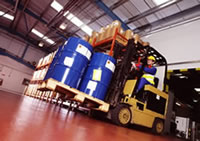
Safe Storage
- Keep storage areas free of combustible materials such as chips, leaves, rags, pallets, paper, and so on.
- Avoid stacking containers to prevent a tip-over and spill. OSHA allows a maximum of two drums stacked with a pallet between to prevent excess stress on the walls of the drums.
- Don’t store solvents with incompatible materials such as oxidizers.
- Make sure storage areas are cool and out of direct sunlight to prevent high temperatures from increasing the amount of vapor in the air.
- Don’t store or dispense solvents near electrical panels, furnaces, or other ignition sources.
Deliver fast and effective Environmental, DOT, and OSHA training with Environmental Training Library. Try it at no cost or risk. For a limited time, also receive a free special report. Download Your Free Report
Safe Handling
- Keep small supplies of solvents to be used during the workday in UL-listed approved, fire-resistant safety containers that have selfclosing lids.
- Make sure that containers are properly labeled with the name and hazards of the solvent.
- Take only the amount of solvent you need for the job. That way if a spill or fire does occur, the damage will be minimal.
- Practice good housekeeping by disposing of solvent-soaked rags in designated closed containers.
- And finally, never weld or torch cut a drum that once contained a solvent. Vapors remaining in the drum could ignite and cause an explosion.
Download your FREE special report, Hazwaste Container Management: Where EPA Inspectors Look First, and receive a 30-day trial of Environmental Training Library at no cost or obligation. Download Your Free Report
General Solvent Safety
Workers who use solvents or work around them should also be aware of these safe work practices to prevent injury to themselves. Train them to:
- Avoid eating, drinking, or keeping food and beverages in solvent areas. This increases the chances of accidentally ingesting solvents.
- Avoid washing hands with solvents. Exposing skin to solvents could result in a rash, dryness, or other skin problems. And, dangerous solvents can get through the skin into the bloodstream and make you sick.
- Always wear required PPE to prevent hazardous exposures to solvents.
- Remove PPE carefully when finished working to avoid getting solvents on the skin.
- Wash thoroughly after working with solvents—and before eating, drinking, or using the rest room. Also wash before leaving the work area for other parts of the facility. Failing to do so could spread chemical contamination to other parts of the facility and put other employees at risk.
- Whenever possible, substitute less hazardous solvents to minimize the risk of exposures. (They should check with a supervisor before making any substitutions.)
See tomorrow’s Advisor for training help on preventing solvent spills.
